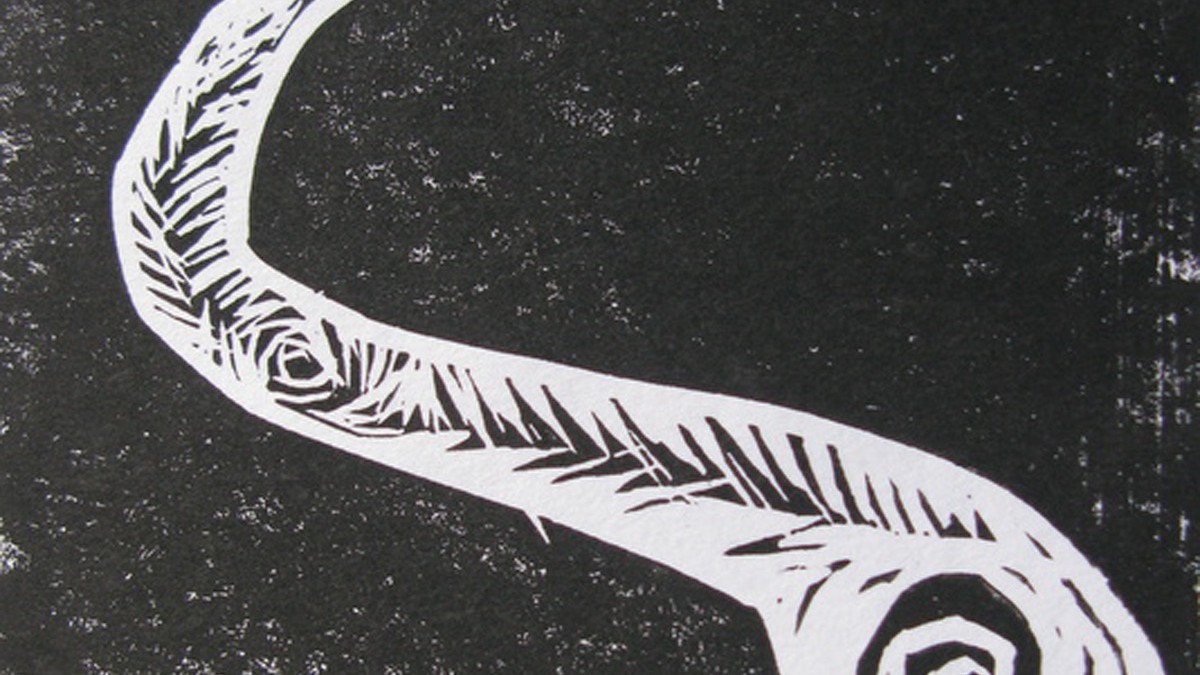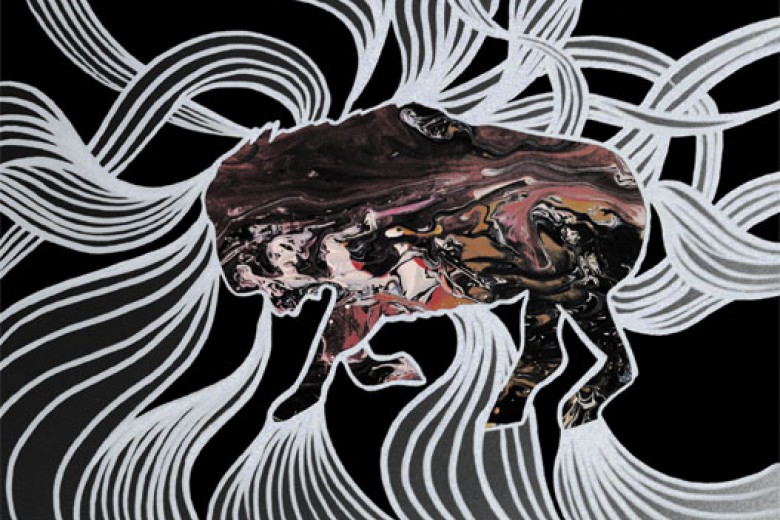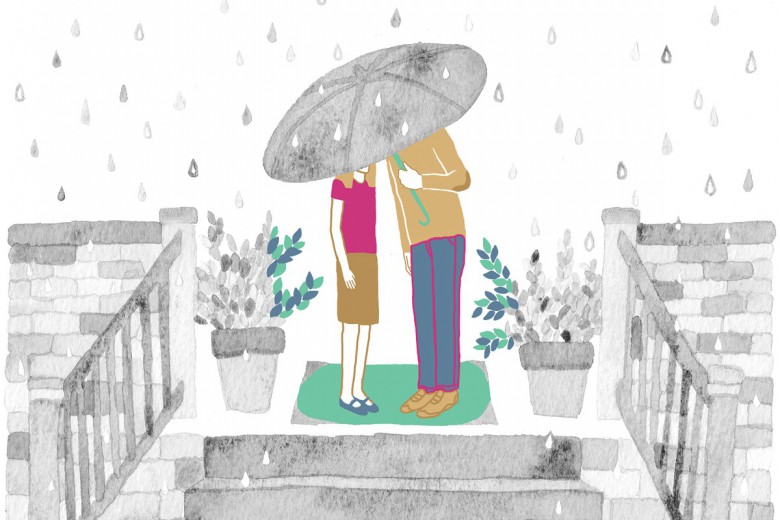A little girl crawls out of the Assiniboine River while people line up in rows to remember their war dead. Row on row with poppies made by prisoners trapped in long hallways in the dark. Rows of prisoners and rows of people crying for their long-dead fathers, old men teetering on benches with medals dripping down one lapel, and a little girl crawls alive out of the slushy water in November.
Remember, remember, remember this image. You brutalized, you lied-to soldiers. You did not protect her, and so; you did not protect anyone.
After the news on the radio, they play some music. I have to ask: where is the rhythm in your music from? The most compelling beats seem to be what would be played in war. Our music favours 4/4 time because it is the rhythm of marching.
My favourite musicians have no time. They meander like a river through sound and eventually arrive at the beginning again. I guess their time is zero. And now, when I listen to such songs, time stops. I like that. This music goes nowhere and it’s not out to conquer anything.
Can you imagine a three-dimensional honeycomb? With walls that extend forever, or perhaps fold in onto themselves in three dimensions after a very long dimension of time?
If you have a dog, you can imagine the honeycomb structure of the entire universe. A dog, generally, will always be touching you. Leaning on your calf, a paw on your shoe. A head in your lap. Yes, dogs understand the honeycomb structure of the universe.
I’ll tell you something else I was told a long time ago. Someone built a lodge out of willow saplings, a half-spherical building with four layers of willows horizontal to the ground binding the willows stuck into the ground. Then this person said quietly, so that all the other white people there missed it: “This is the four levels above earth, but this is just a reflection of the four levels below earth.” Which made the structure a complete sphere, and in harmony with the honeycombs that string the universe together, they made that structure physical which exists everywhere, and then they sat on the ground in it, suspended between four above and four below.
Dogs are never disconnected from your body. They hear you move, they read your thoughts. Most animals know there is something below the ground that is not there for mining. Most animals know their own medicine, and select the plants they need. You are never more than six feet away from a spider anywhere in the world, and when a frost makes the spiders webs visible you see that they bind all things together, so that everything touches.
Gravity pulls, snowflakes meander down along the threads of the walls of the honeycomb. So above, so below, humans used to know what dogs know, who know what spiders know. Tiny spiders spin a thread of web and use it to travel miles on the breeze, did you know they had flight? They are so far from home and yet they have the whole world as their home, six feet away is a wall of honeycomb and a spider like them. Floating along the paths created by gravity and wind, which the moon made by sloshing waves in the sea towards itself along a wall of unseen force.
And in the troughs of every wave, a tiny boat, criss-crossed with human beings lying down, fleeing the bombs. They will be pulled from the water, they will flee the bombs which my neighbours drop. Every day the war planes practise over my house, a twenty-one-year old in the cockpit practising war. Underneath, in the school yard the kids are frogmarched into the concrete structure. The jets fly in formation overhead.
November is fireball season. Not just bombs, but meteors, fall to earth.
Apparently, when I am 73, the Leonid meteor shower will again produce 100,000 fireballs per hour. Sometimes I think staying alive that long would be worth it to see the sky alight with fire.
Like silent bombs.
So many of the profound things we see are silent. And some of the profound music we hear has an unexpected source. I heard two groups of chickadees fighting and singing one day. On either side of my head they were bubbling and squeaking and flying. If one chickadee chooses a note, another chickadee will sing just a quarter tone below.
They were talking to one another over my head; they had a lot to say. In their music there were quarter tones, like the music of my ancestors.
We just assume we can talk, and we just assume we can waste and squander words, and some people talk but never say anything true. Cops try and use big words in every sentence: “The suspect became deceased at the scene and members failed to revive. I would be negligent to say more at this juncture.”
Gossips go on and on and on until they run out of breath. People can talk without saying anything at all.
But now I have to tell a story, because, after all, that’s what this is. And I don’t want to.
I was driving on a gravel road, and the snow had newly fallen. I saw on top of a steel fence post, I saw the body of a dog – no, a coyote. And the body was actually impaled on the metal post. So I stopped. I went to the body of the coyote, which was face down, stomach open on the post, frozen and in rigor mortis. I took the body and lifted it from the post. It was light. A long intestine trailed along the ground like a red banner as I carried the body to the other side of the road, where ravens feast in the ditch. Then I looked at the coyote’s thick red fur and realized this was only a pup – maybe six months old, tiny bright teeth, thick ears, bushy tail. I put the body in the ditch among the leaves and said goodnight.
I thought of the horse that Dostoevsky saw whipped in the street. One image I cannot forget from a book. This coyote pup is an image I cannot forget, and never will, I know, because I fully understood the message it sent. A sign of brutality, that the killers somehow thought the wild dogs would understand. Instead, it tells me, “Be careful; these people are killers and they do not respect life.”
But now I see that it is the same web that connects them. I heard the news on the radio. And someone has left a young girl in the river. They left her there to die. These are the same people. Be careful, they are everywhere around in this country. She was in the river and she climbed out. They are throwing the girls in the river and they seldom crawl out again. If you live here you know about the brutality. I can meet neighbours here who feed it every day, who speak about it, the old racists, who are brutal in their language and action. They want to break the world.
I have to stop listening to the jets and the school yard buzzers, the wind that comes from the ocean full of tiny boats. I have to remember someone I met at the top of a mountain because the web of honeycomb needs all of its threads.
This quiet person lived in a town on the very top of a mountain in the Alps. This one had started in the valley beside the river, in medieval times. The town got attacked a lot – looted, I suppose – so they kept moving the town up the mountain. And eventually, there it stuck, at the very top, with a winding road all the way up, one lane, small cars only, donkey track. The houses, barns, and a churchyard with graves were all crowded at the summit. So when you got to the top and slogged through deep snow in November to the churchyard you could see out across the tips of other mountains shrouded in snow and clouds and the light jutting in long beams from the yellow sun.
It was a fairy tale scene.
This person was born here. I think he was called Tomorrow. This is why he was so quiet. The town bullies picked on him from a young age, up in the clouds and snow at the fairy tale town at the top of a mountain. He was bullied. And he got so quiet. He was tall, and a little hunched at the top, like bullied people are, and thin. He wore corduroy pants, of a light brown colour, and a jacket. He had reddish hair and he was exceedingly handsome, in a casual way.
He spoke some English, but he only whispered to our mutual friend, he never spoke aloud.
Driving back down the mountain late that night, swerving the small European deer and sliding in the snow, I did ask him a few direct questions. I used a soft voice so as not to startle him and he answered but without elaboration, exactly the way you’d expect.
I wanted to write a fable about a town so rare and beautiful and magical where stupid bullies still ruined people. But really, the tale was written by itself, all of it. I had nothing to add.
Tomorrow and tomorrow and tomorrow, and yesterday as well, creeps both forwards and backwards exactly as space is structured. Let us follow the honeycomb structure of webs we can’t see in all directions, for this is the nature of the universe and the shape of a story.







